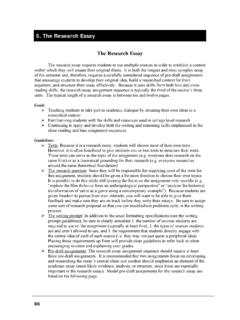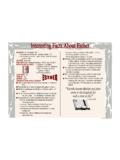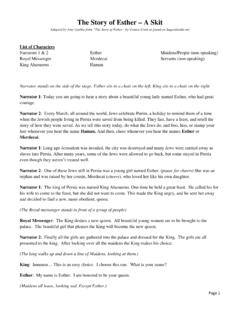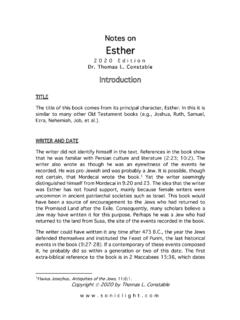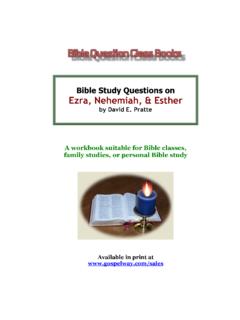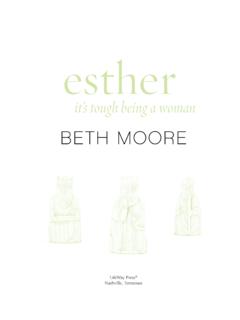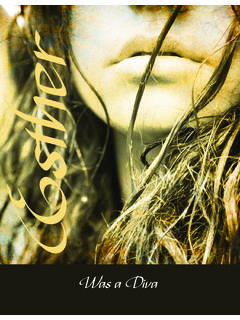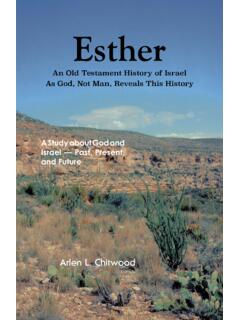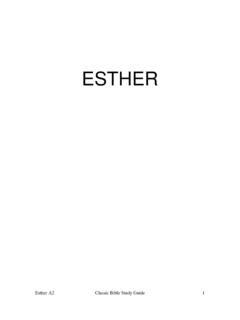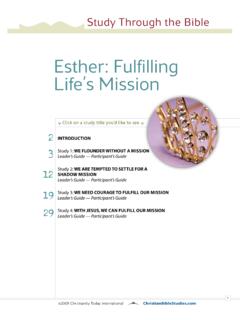Transcription of Reading Esther - Cultural Impact on Responses to Biblical ...
1 Fishman, Responses to Biblical Heroines,1 Reading Esther : Cultural Impact ON Responses TO Biblical HEROINES Sylvia Barack Fishman Co-Director, Hadassah International Research Institute on Jewish Women at Brandeis University Associate Professor, Near Eastern and Judaic Studies Brandeis University February 2002 Hadassah International Research Institute on Jewish Women at Brandeis University Working Paper Fishman, Responses to Biblical Heroines,2 Reader response to Megillat Esther Contemporary literary theorists have encouraged readers to expose socio-political agendas encoded in literary works. Feminist readers use these deconstructionist critical strategies effectively to unmask and confront problematic attitudes toward women in a broad range of religious, literary, scientific, and popular texts, including portrayals of women in the Bible.
2 In this paper, I look at readers Responses to the Biblical Book of Esther , specifically the version of the narrative found in the Hebrew Bible and its English My goal is to explore the way cultures shape diverging reactions to this text. I focus on suggestive ideas and parallels, and in no way intend this discussion to represent a comprehensive overview of any one group of readers. I begin with a review of four questions suggested by contemporary feminist readers who work to deconstruct the dominant paradigms of Biblical interpretation and reconstruct them, with the goal of understanding these texts in ways which do not legitimate patriarchal oppression. 2 I suggest that, perhaps surprisingly, several questions that trouble feminist readers were anticipated by some medieval rabbinic commentators. I summarize the views and interpretations of these rabbinic readers, and explore their concerns.
3 Finally I offer a selection of critical approaches suggested by scholars of the Biblical period. Insights provided by Biblical scholars, some of whom are themselves feminists, explore historicity, language, genre, and narrative techniques and bring a crucial dimension to our understanding of the text. I am especially interested in those scholarly approaches enabling readers to perceive the deeper social critique of the Persians and their rulers within the text of Megillat Esther . Contemporary feminist readers raise important questions, including the following: Fishman, Responses to Biblical Heroines,3 (1) Esther Fuchs emphasizes the fact that God s name is not mentioned in this book which has a woman as the hero, and asserts that the omission of God s name is evidence of a comprehensive Biblical policy which allows women characters to hold direct discourse with God (or his agent) only in a procreative context.
4 (2) Fuchs castigates Megillat Esther for underscoring what she sees as a patriarchal ideology which rewards obedience and submissiveness in a woman, and which portrays women getting their way only when they are sly and (3) Susan Schnur proposes an unbroken link between the pagan, polytheistic source materials and the canonized texts and Judaized holidays which emerged as Megillat Esther and (4) Readers such as Shulamit Reinharz note that when Ahasueros rounds up all the virginal young women and sequesters them into the palace, the text does not appear to condemn the sexual enslavement of women. Reinharz wonders why even Esther seems to have accepted or have been unable to question the king s practice of sexually enslaving women, since her request to the king said nothing about other women in captivity already. 5 Perhaps unexpectedly, rabbinical exegetes were troubled by many of the same questions.
5 Rabbis living in Spain, Italy, France and Morocco from the eleventh through the fifteenth centuries identified very closely with Esther s situation. When these rabbis looked at Esther s plight in the Persian court they thought of Jews in the courts of Spain and other European countries. They were also reminded of the ways in which religious persecution impinged on their own families and lives. As Barry Dov Walfish demonstrates, these rabbis were appalled by the fact that Esther was seized and whisked off to the harem of a gentile potentate, without any recorded protest by Mordecai, the Jewish community, or indeed by Esther herself. Abraham Ibn Ezra [Spain, Italy, and Fishman, Responses to Biblical Heroines,4 France, ca. 1089- ca. 1164] insists that the use of the passive verb, va-tillikakh, emphasizes the fact that Esther was taken against her will.
6 Ibn Ezra was a brilliantly gifted and prolific poet, grammarian, Biblical commentator, philosopher, astronomer, and physician. In 1140 he left Spain and wandered through Italy and France until he died; historians believe his troubled spirit and the restless wandering that resulted from it was due to the real or alleged conversion to Islam of his only surviving son. 6 Abraham Saba [Spain and Morocco, mid-fifteenth-early sixteenth centuries] exiled from Spain to Morocco, is tormented by the fate of Esther , which hits close to home and reminds him of the martyrdom of many of his co-religionists: Now when Mordecai heard the king s herald announcing that whoever had a daughter or a sister should bring her to the king to have intercourse with an uncircumcised heathen, why did he not risk his life to take her to some deserted place to hide until the danger would pass, or even to take her to another kingdom?
7 And if he could do neither of these things, have we not seen with our own eyes during the expulsion from Portugal, when sons and daughters were taken by force and converted, that Jews strangled and slaughtered themselves and their why did Mordecai not do one of those things that the simplest Jews in Portugal did?..Why was he not more careful? Where was his righteousness, his piety, and his surrendered to the enemy all that was dear to Saba s frustration with Mordecai is also informed by his own personal suffering. In 1497 when the forced conversion of the Jews was declared in Portugal, Saba s two sons were baptized. He fled to Lisbon, where he was imprisoned with other Contemporary readers may challenge Abraham Saba that Mordecai should have strangled Esther rather than allowing her to be taken into the King s harem.
8 However we learn about the power of milieu to shape a reader s understanding of a text, as we observe Fishman, Responses to Biblical Heroines,5 this medieval commentator s pain. The exiled Jews of Persia remind him of the suffering of the Iberian Jews on a very immediate and poignant level. Medieval exegetes valorized Esther not as a proper Jewish woman, but as a model for all Jews, including Jewish men. The rabbis of medieval Europe often saw the Book of Esther as a how-to book or self-help manual for Jewish survival among the elite classes in Diaspora communities. Esther was interpreted as the epitome of the clever courtier who understands how a subject should approach a ruler in order to accomplish difficult goals. Skill in this regard was especially critical for aristocratic Diaspora Jews, who were always in a potentially vulnerable position as they navigated their way as outsiders through the courts.
9 Especially striking is the gender-neutral mode in which these medieval rabbis praise Esther s skills as a courtier. The rabbis assess Esther as a consummate politician. For example, Zecharia ben Sarukh [fifteenth century, Spain and Morocco] calls Esther medinit, a good statesperson. Isaac Arama [1420-1494, Spain] similarly, credits Esther for bringing her endeavor to successful fruition by taking into consideration five important factors: (1) timing--bringing the plight of the Jews to the king s attention only after three encounters; (2) location--she brought the King and Haman into her own home, where no one could speak out against her; (3) means--the wine-banquets so loved by Ahasueros, which would make him feel well-disposed toward her request; (4) rhetoric--the order and phrasing of her request; and (5) flattery--tailoring her request to the person of whom she is requesting the favor.
10 Along the same lines, Isaac ben Joseph ha-Kohen [late fourteenth-early fifteenth century, Spain] speaks of Esther as a model for courtiers by having in mind that all motivations for the request must appear to be beneficial to the Fishman, Responses to Biblical Heroines,6 person from whom the request is made. According to ha-Kohen, Esther s request to Ahasueros made it clear that the King would benefit from Esther s request, that her request was for a proper and fitting action, that she herself had previously found favor in the King s eyes, and that since the King owed the Jews a favor he was bound to reciprocate. A third variation of this theme is found in the commentary of Joseph Hayyun [fifteenth century, Portugal]. He claims that Esther s language supplied the King with four rationales for accepting her request: First, if it please the King, indicating that the action will be for the King s own benefit.


